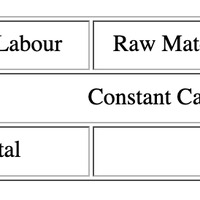-
Title
-
Components of Productive Capital
-
Description
-
Following the analysis of the labor process in Volume I of Capital, … the elements of productive capital comprise raw and auxiliary materials, instruments of labor, and labor-power. These factors enter differently into the fabrication of the product. Raw and auxiliary materials are wholly consumed in the productive process, although only the former enter materially into the product. Instruments of labor (including, for example, tools, machines and buildings) wear away gradually, and are hence employed in more than one labor process. Together, raw materials, auxiliary materials, and instruments of labor constitute means of production. Labor-power, used as labor, transforms means of production into a product.
In value terms, the value of means of production is transmitted to the product as these means of production are used up in the productive process. The value of raw and auxiliary materials, therefore, is wholly incorporated in an individual product, while the value of instruments of labor is transmitted piecemeal (i.e., is distributed over many products) as their use-value wears away. Because the means of production merely transfer their value to the product, Marx termed this portion of productive capital "constant" capital. Labor-power, on the other hand, creates new value when employed as labor in the productive process. When the worker labors beyond necessary labor time, surplus-value is created, and the portion of capital advanced for labor-power expands its value in production. Marx, therefore, termed this portion of productive capital "variable" capital.
Marx's consideration of the manner in which different components of productive capital circulate leads to the distinction between fixed and circulating capital. Because the value of raw and auxiliary materials is wholly incorporated in the product, this value is circulated with the product, and returns completely to the capitalist as soon as the commodity product is sold. Likewise, money laid out in wages reappears in the value of the product and circulates with it. … For this reason, raw and auxiliary materials, and labor-power comprise circulating capital.
In contrast, because the value of instruments of labor is spread over the products of many production periods, only part of their value circulates with the product of a single such period. Part of their value, then, remains (is fixed) in the sphere of production, and, for this reason, instruments of labor constitute fixed capital. The several, parallel distinctions applied to the elements of productive capital are shown in [the Figure].
-
Designer
-
Fox, John
-
Date
-
1985
-
Source
-
Understanding Capital Volume II
-
Bibliographic Citation
-
John Fox, 1985. Understanding Capital Volume II. Progress Books. Figure 3
 Figure3.png
Figure3.png